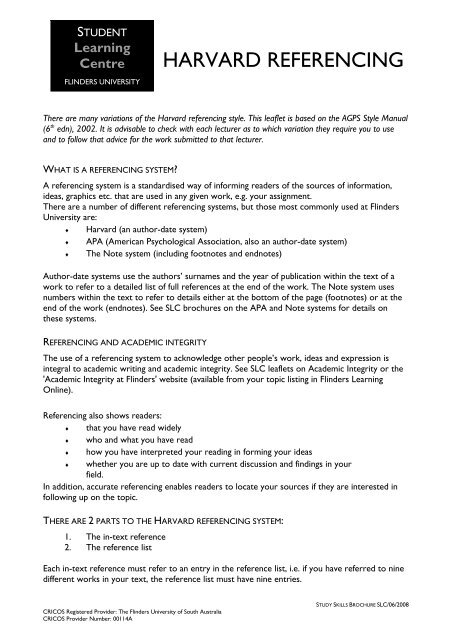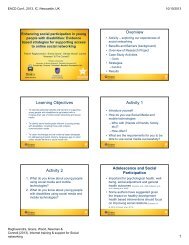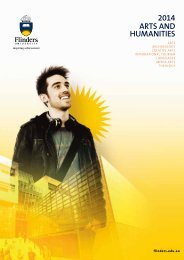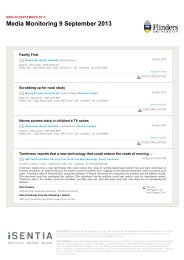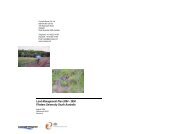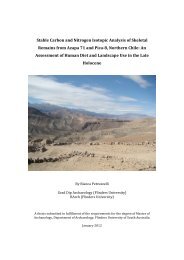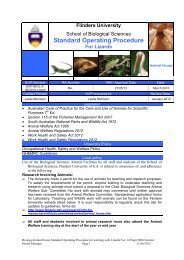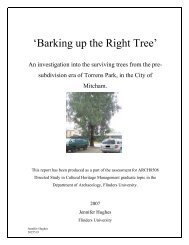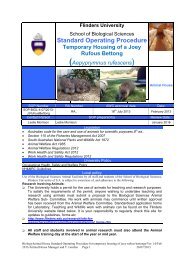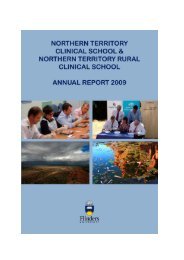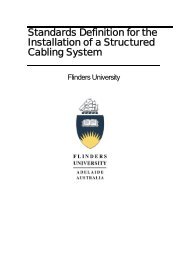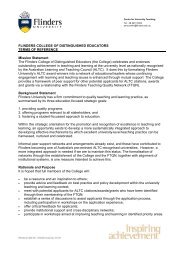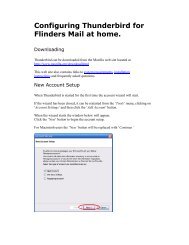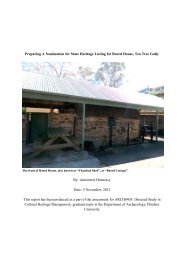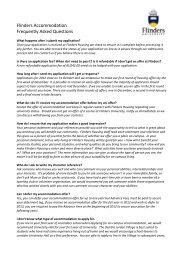HARVARD REFERENCING - Flinders University
HARVARD REFERENCING - Flinders University
HARVARD REFERENCING - Flinders University
Create successful ePaper yourself
Turn your PDF publications into a flip-book with our unique Google optimized e-Paper software.
STUDENT<br />
Learning<br />
Centre<br />
FLINDERS UNIVERSITY<br />
CRICOS Registered Provider: The <strong>Flinders</strong> <strong>University</strong> of South Australia<br />
CRICOS Provider Number: 00114A<br />
<strong>HARVARD</strong> <strong>REFERENCING</strong><br />
There are many variations of the Harvard referencing style. This leaflet is based on the AGPS Style Manual<br />
(6 th edn), 2002. It is advisable to check with each lecturer as to which variation they require you to use<br />
and to follow that advice for the work submitted to that lecturer.<br />
WHAT IS A <strong>REFERENCING</strong> SYSTEM?<br />
A referencing system is a standardised way of informing readers of the sources of information,<br />
ideas, graphics etc. that are used in any given work, e.g. your assignment.<br />
There are a number of different referencing systems, but those most commonly used at <strong>Flinders</strong><br />
<strong>University</strong> are:<br />
♦ Harvard (an author-date system)<br />
♦ APA (American Psychological Association, also an author-date system)<br />
♦ The Note system (including footnotes and endnotes)<br />
Author-date systems use the authors’ surnames and the year of publication within the text of a<br />
work to refer to a detailed list of full references at the end of the work. The Note system uses<br />
numbers within the text to refer to details either at the bottom of the page (footnotes) or at the<br />
end of the work (endnotes). See SLC brochures on the APA and Note systems for details on<br />
these systems.<br />
<strong>REFERENCING</strong> AND ACADEMIC INTEGRITY<br />
The use of a referencing system to acknowledge other people’s work, ideas and expression is<br />
integral to academic writing and academic integrity. See SLC leaflets on Academic Integrity or the<br />
'Academic Integrity at <strong>Flinders</strong>' website (available from your topic listing in <strong>Flinders</strong> Learning<br />
Online).<br />
Referencing also shows readers:<br />
♦ that you have read widely<br />
♦ who and what you have read<br />
♦ how you have interpreted your reading in forming your ideas<br />
♦ whether you are up to date with current discussion and findings in your<br />
field.<br />
In addition, accurate referencing enables readers to locate your sources if they are interested in<br />
following up on the topic.<br />
THERE ARE 2 PARTS TO THE <strong>HARVARD</strong> <strong>REFERENCING</strong> SYSTEM:<br />
1. The in-text reference<br />
2. The reference list<br />
Each in-text reference must refer to an entry in the reference list, i.e. if you have referred to nine<br />
different works in your text, the reference list must have nine entries.<br />
STUDY SKILLS BROCHURE SLC/06/2008
1. THE IN-TEXT <strong>REFERENCING</strong><br />
In-text referencing is based on the authors’ surnames, the year of publication and the page<br />
number(s) of the discussion or idea you are referring to.<br />
Use p. for one page, pp. for more than one page.<br />
Smith (2005, p. 45) argues that ‘the relative seriousness of the two kinds of errors differs from<br />
situation to situation’.<br />
It has been argued that ‘the relative seriousness of the two kinds of errors differs from situation to<br />
situation' (Smith 2005, p. 45).<br />
If you paraphrase material (express someone else’s ideas in your own words) you must include a<br />
page number and make it clear that you are referring to someone else's work:<br />
A recent study (Jones & Chan 2002, pp. 30-31) has shown...<br />
When the authors' names are incorporated within the text, you must write the word<br />
and instead of the symbol &:<br />
Jones and Chan (2002, pp. 30-31) have shown that…<br />
Works with four or more authors<br />
Include only the surname of the first author and the abbreviation et al. (meaning 'and the others').<br />
There is no longer any need to write all the authors’ names the first time you refer to their work<br />
in your text, though all the names should appear in your final reference list. In the following<br />
example, the citation refers to work done by Lim, Smith, Brown and Nguyen:<br />
A recent study (Lim et al. 2006) has shown...<br />
Two or more authors with the same surname<br />
Distinguish between them by using the authors' initials or full names:<br />
A recent study by CL Jones (2005) has shown ... but A Jones (2006) has suggested...<br />
Secondary references (when one author discusses another author’s work)<br />
Both sources must be acknowledged in your in-text reference. However, only the book or article<br />
you actually used (the secondary reference) should appear in your reference list. In the example<br />
below, Marini is the primary reference and Jones is the secondary reference:<br />
Marini (Jones 2005) states…<br />
Marini's study in 2003 (cited in Jones 2005) states...<br />
Jones (2005), in reporting Marini's study of 2003, states...<br />
The process was shown to be more complex than at first thought (Marini 2003 cited in Jones 2005).<br />
When citing several references at the same point, separate the authors' names by semi-colons,<br />
with surnames in alphabetical order:<br />
Recent studies (Brown 1991; Kuwlesky 1988; Wong & Smith 1993) have shown...<br />
CRICOS Registered Provider: The <strong>Flinders</strong> <strong>University</strong> of South Australia<br />
CRICOS Provider Number: 00114A<br />
STUDY SKILLS BROCHURE SLC/06/2008
References to two or more publications in the same year by a given author should be<br />
distinguished by adding a, b etc. to the date.<br />
A recent study (Jones 2006b) has shown…<br />
Recent studies (Jones 2005, 2006a, 2006b) have shown…<br />
References to personal communications such as interviews, telephone conversations, emails etc.<br />
can be provided in parentheses ( ), or in the text itself. Information should include the author’s<br />
initial, surname, type of communication and the date). Personal communications are not included<br />
in the reference list.<br />
In an email on 15 August 2007, Dr R Fletcher suggested that the recent findings were of high significance.<br />
It has been suggested that the recent findings were of high significance (R Fletcher, 2007, email, 15 August).<br />
2. THE REFERENCE LIST<br />
The reference list is placed at the end of the assignment. It is arranged in alphabetical order of<br />
authors' surnames and chronologically for each author, with the items marked below with an<br />
asterisk (*) being essential.<br />
When using the Harvard system for books, the following information is required in this order:<br />
♦ author's surname & initials *<br />
♦ year of publication *<br />
♦ title of publication (in italics) *<br />
♦ title of series (if applicable)<br />
♦ volume number or number of volumes (if applicable)<br />
♦ edition (if applicable)<br />
♦ editor, reviser, compiler or translator (if other than the author) *<br />
♦ publisher *<br />
♦ place of publication *<br />
♦ page numbers (when applicable, e.g. for a chapter in a book)<br />
Book<br />
Angelil-Carter, S 2000, Stolen language? Plagiarism in writing, Longman, London.<br />
Chapter in an edited book<br />
Fox, R 2000, ‘Online technologies changing university practices’, in A Herrmann & M Kulski (eds), Futures in<br />
university teaching, Centre for Educational Advancement, Curtin <strong>University</strong> of Technology, Perth, pp. 235-243.<br />
When referencing material from journals (periodicals) the following order is required:<br />
♦ author's surname & initials *<br />
♦ year of publication *<br />
♦ title of article (in inverted commas) *<br />
♦ title of journal or periodical (in italics)*<br />
♦ title of series (if applicable)<br />
♦ place of publication ( if needed to distinguish between different<br />
periodicals with the same title<br />
CRICOS Registered Provider: The <strong>Flinders</strong> <strong>University</strong> of South Australia<br />
CRICOS Provider Number: 00114A<br />
STUDY SKILLS BROCHURE SLC/06/2008
♦ volume number *<br />
♦ issue number (if applicable)<br />
♦ month (if applicable)<br />
♦ page number or numbers *<br />
Campbell, M 2003, ’Dorothy Smith and knowing the world we live in’, Journal of Sociology and Social Welfare,<br />
vol. 30, no. 1, March, pp. 3-22.<br />
When referencing World Wide Web pages, the following order is required:<br />
♦ author – the person or organisation responsible for the page<br />
♦ site date (either the date it was last updated, a copyright date or n.d. (no<br />
date), if date not available)<br />
♦ name and place of sponsor of website<br />
♦ the date you viewed the site<br />
♦ the web address<br />
<strong>Flinders</strong> <strong>University</strong> n.d., <strong>Flinders</strong> <strong>University</strong> homepage, viewed 14 December 2006, .<br />
When referencing documents within a website:<br />
♦ author, editor or compiler<br />
♦ date of document (either copyright date, when it was last updated or n.d. ,<br />
if no date)<br />
♦ title of document<br />
♦ version no. (if applicable)<br />
♦ description of document (if applicable)<br />
♦ name of sponsor of site<br />
♦ the date you viewed it<br />
♦ the web address<br />
<strong>Flinders</strong> <strong>University</strong> 2006, ‘Making a smarter sunscreen’ (News and Research Story, 5 December 2006), viewed<br />
14 December 2006, .<br />
CRICOS Registered Provider: The <strong>Flinders</strong> <strong>University</strong> of South Australia<br />
CRICOS Provider Number: 00114A<br />
STUDY SKILLS BROCHURE SLC/06/2008
EXAMPLES<br />
BOOKS<br />
One author<br />
Two authors<br />
More than two authors<br />
No author<br />
Edited work (editor's role not<br />
paramount)<br />
Edited work (editor<br />
paramount)<br />
Chapter in edited book<br />
Sponsored by an<br />
institution, corporation.<br />
Conference paper (published)<br />
Government publication<br />
Government report<br />
Topic/Course materials<br />
CRICOS Registered Provider: The <strong>Flinders</strong> <strong>University</strong> of South Australia<br />
CRICOS Provider Number: 00114A<br />
Everitt, BS 1996, Making sense of statistics in psychology, Oxford<br />
<strong>University</strong> Press, Oxford.<br />
Shaughnessy, JJ & Zechmeister, EB 1997, Research methods in<br />
psychology, 4 th edn, McGraw-Hill, Singapore.<br />
Hay, I, Bochner, D & Dungey, C 2002, Making the grade, 2nd<br />
edn, Oxford <strong>University</strong> Press, Melbourne.<br />
Computer graphics inter-facing 1996, 3rd edn, Modern<br />
Technology Corporation, Minneapolis.<br />
The young persons’ guide to anarchy 1995, ed. Heinrich A<br />
Stumpendorfer, Hard Core Press, Berlin.<br />
Broom, TE (ed.) 1990, Analytical chemistry: theory and<br />
techniques, M Dekker, New York.<br />
Shark, JJ 1993, 'Hormones in fish', in RL Whiting & SS Trout<br />
(eds), The fishing industries of the South Atlantic, 5th edn, Seaside<br />
Publishing Company, New Hampshire, pp. 456-472.<br />
Centre for Student Learning 1996, Methods of learning in<br />
science, ed. J Davies, Harper Collins, Sydney.<br />
Smith, FL 1996, ‘An academic orientation program for<br />
commencing students’, Proceedings of the Australasian Science<br />
Education Research Association, <strong>University</strong> of Canberra,<br />
Canberra, pp. 24-26.<br />
Australian Bureau of Statistics 1990, New technology approvals<br />
in Australia, cat. no. 7779.1, ABS, Canberra.<br />
Department of Education, Science and Technology 2002,<br />
Higher education at the crossroads: ministerial discussion paper,<br />
DEST, Canberra.<br />
School of Humanities, <strong>Flinders</strong> <strong>University</strong> 2003, Professional<br />
English course book, ENGL 1001, semester 2, <strong>Flinders</strong><br />
<strong>University</strong>, Adelaide, p. 135.<br />
STUDY SKILLS BROCHURE SLC/06/2008
PERIODICALS<br />
Journal (no author)<br />
Journal (one author)<br />
Journals (more than one<br />
author)<br />
Journal (No volume or issue<br />
number)<br />
Newspaper article<br />
Magazine article<br />
OTHER SOURCES<br />
Standards<br />
Patent<br />
Pamphlet<br />
DVD, Video, television<br />
(identify the medium)<br />
Microfiche<br />
Musical recording<br />
Legal Case<br />
Reference to Legal Authority<br />
CRICOS Registered Provider: The <strong>Flinders</strong> <strong>University</strong> of South Australia<br />
CRICOS Provider Number: 00114A<br />
‘New methods of laser detection' 1994, Laser Technology, vol. 25,<br />
p. 309.<br />
Ramsden, P 1985, ‘Student learning research: retrospect and<br />
prospect’, Higher Education Research & Development, vol. 4, no.1,<br />
pp. 51-69.<br />
Boyl, EA, Duffy, T & Dunleavy, K 2003, ‘Learning styles and<br />
academic outcomes: the validity and utility of Vermunt’s<br />
Inventory of Learning Styles in British higher education', British<br />
Journal of Educational Psychology, vol. 73, pp. 267-290.<br />
Crassinmore, F 1994, 'A better mouse-trap?', Creative Technology,<br />
September, pp. 32-35.<br />
Martyr, HE 1994, 'The debate into racism in Australia', The<br />
Australian, 13 August, p. 14.<br />
Raloff, J 2001, ‘Lead therapy won't help most kids’, Science News,<br />
vol. 159, 12 May, p. 292.<br />
Standards Association of Australia 1991, Australian standard for<br />
cauliflowers and cabbages, AS 1455-1991, Standards Australia,<br />
Sydney.<br />
Tan, IS & Arnold, FF (US Air Force) 1993, In-situ molecular<br />
composites based on rigid-rod polyamides, US Patent 5 247 057.<br />
Quit: give smoking away in 5 days 1987, Victorian Smoking and<br />
Health Program booklet, Health Department Victoria, Anti-<br />
Cancer Council and National Heart Foundation, Melbourne.<br />
The life of fish 1999, video recording, Canadian Wildlife Services,<br />
Vancouver.<br />
Wells, HG 1887, microfiche, The Martian canal industry: an<br />
overview, Australian Science Fiction Council, Canberra.<br />
Waits, T 1985, cassette recording 61180-4, Blue valentine,<br />
Asylum Records, Oakland, California.<br />
The State of South Australia v. The Commonwealth (1915) 20 CLR<br />
54<br />
Latham, CJ & McTieran, J in Attorney-General (Vic.) v. The<br />
Commonwealth (1946) 71 CLR at 253-6 and 273-4.<br />
STUDY SKILLS BROCHURE SLC/06/2008
Thesis<br />
Unpublished conference<br />
paper<br />
ELECTRONIC SOURCES<br />
Article from an electronic journal<br />
Journal article from a full-text online<br />
database<br />
Web document<br />
Website with no date<br />
CD Rom<br />
Electronic mail list or bulletin board<br />
Computer program<br />
CRICOS Registered Provider: The <strong>Flinders</strong> <strong>University</strong> of South Australia<br />
CRICOS Provider Number: 00114A<br />
Trout, NA 1996, ‘Spectroscopic, stereochemical and reactivity<br />
studies in the adamantane ring system’, PhD thesis, <strong>Flinders</strong><br />
<strong>University</strong>, Adelaide, Australia.<br />
Melanti, BG 1982, ‘Programmers' attitudes toward computer<br />
crime: the case in Hong Kong’, paper presented to 10th World<br />
Congress of Computer Technology, Kathmandu, 16-21 August.<br />
Birbeck, D & Drummond, M 2006, ‘Very young<br />
children’s body image: bodies and minds under<br />
construction’, International Education Journal, vol. 7,<br />
no. 4, September, viewed 12 December 2006,<br />
.<br />
Kember, D, Biggs, J & Leung, D 2004, ‘Examining<br />
the multidimensionality of approaches to learning<br />
through the development of a revised version of<br />
the LPQ’, British Journal of Educational Psychology,<br />
vol. 74, no. 2, pp. 261-279, viewed 4 May 2004,<br />
(online Bell & Howell/ProQuest).<br />
Phillips, R 2004 David Hicks details abuse in<br />
Guantanomo Bay,<br />
World Socialist website, viewed 11 December<br />
2006,<br />
.<br />
<strong>Flinders</strong> <strong>University</strong> Student Learning Centre n.d.<br />
Article reviews, viewed 12 December 2006,<br />
.<br />
The Comedy Store 2002, The art of comedy, CD-<br />
ROM, Western Publishing, New York.<br />
Scrooge, E 2003, ‘The<br />
life and times of a superstar’, list server, 1 April,<br />
Dickensian Society of London, viewed 5 April,<br />
.<br />
Pamula, F & Zeegers, P 1996, Writing in the<br />
sciences, Windows 95, Science Software<br />
Consortium, <strong>Flinders</strong> Technologies.<br />
STUDY SKILLS BROCHURE SLC/06/2008
FURTHER INFORMATION<br />
For more comprehensive information about the use of the latest version of the Harvard<br />
referencing system, please refer to:<br />
Australian Government Publishing Service 2002, Style manual for authors, editors and printers,/revised by Snooks &<br />
Co., 6th edn, John Wiley & Sons, Canberra, pp. 187-231.<br />
The School of Nursing & Midwifery’s Author-date (Harvard) referencing guide is another useful<br />
source to look at, providing more examples and explanations. It is available at:<br />
<br />
There is also an SLC leaflet giving details of how to make online referencing enquiries.<br />
CRICOS Registered Provider: The <strong>Flinders</strong> <strong>University</strong> of South Australia<br />
CRICOS Provider Number: 00114A<br />
STUDENT LEARNING CENTRE<br />
STUDENT CENTRE, LEVEL ONE<br />
TELEPHONE: 61-8-8201 2518<br />
FAX: 61-8-8201 3839<br />
E-MAIL<br />
slc@flinders.edu.au<br />
INTERNET<br />
http://www.flinders.edu.au/SLC<br />
POSTAL<br />
PO BOX 2100, ADELAIDE, SA 5001<br />
STUDY SKILLS BROCHURE SLC/06/2008


